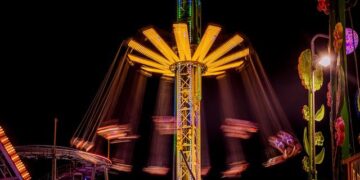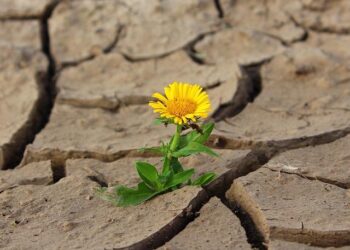This article was produced by National Geographic Traveller (UK).
If you’re looking for a symbol of Berlin’s 20th-century history, you could do a lot worse than the Teufelsberg. Rising out of the Grunewald forest, at the western edge of the city, this 375ft hill is made almost entirely out of the wreckage of the Second World War. Bricks mainly, but also broken lintels, smashed tiles and pock-marked stone: in the end, 26 million cubic metres of the stuff, cleared from Berlin’s streets, was dumped here over the half-finished shell of a military academy. The Nazis had been building it when, in 1945, Stalin’s tanks rolled in.
Then, the British and Americans placed a listening post on top, crowned with a handful of antennas encased in domes like great, white golf balls. Once staffed by 1,500 Cold War spies, it didn’t just monitor Communist conversations; West German journalists suspected their telephone calls were being bugged, too. No wonder they called it the Teufelsberg — teufel is German for ‘devil’.
Now, the scene is rather different. The Allies shipped out in 1991, and before anyone could agree what to do with the site, locals were cutting holes in its perimeter fence and wriggling through. Some just wanted to see what all the fuss had been about; others brought cans of spray paint.
“How could it have been otherwise?” says Berlin artist and Teufelsberg guide Richard Rabensaat, when he takes me up there one midweek morning. “It was a wonderful, adventurous place, full of secrets,” he says. “And you could paint there without fear of being stopped by the police.”
Pretty soon, the Teufelsberg became an unofficial open-air gallery of street art — and that status was officially confirmed in 2014. When it first opened, full time, to the public, 5,000 people a day were crowding in.

Once a half-finished shell of a military academy, the Teufelsberg became an unofficial open-air gallery of street art — and that status was officially confirmed in 2014.
It’s much quieter now, and at first the overwhelming impression is of dilapidation. Only Mother Nature seems purposeful, coiling ivy around drainpipes and sending silver birches shimmering through gaps in the tarmac. The Teufelsberg’s vaunted artwork seems secondary to the sense of decay. Then we round a corner, and lay eyes on the back of the building.
What a sight greets me there. This is where its biggest walls are — and across them three different artists have let loose. One of the works is pure Roy Lichtenstein: a pop art melodrama of comic-book emotions. Another is an album-cover-worthy dreamscape of purples, blues and browns. But it’s the largest of the three — painted by Berlin street artist Akut in 2022 — that really holds your gaze.
Here, a black-haired woman, five storeys high, squats against a dark and troubled sky. The mottled paintwork of her skinny arms contrasts delicately with the faultless sheen of her boxing gloves, and in spite of her obvious frailty her look is one of pure defiance. ‘When David turned into Goliath’, the caption reads, alongside the names of a galaxy of era-defining high-achievers — all of them female. Even the resurgent vegetation looks wilted beside the strength of its conviction. And it’s clear that Berlin still blazes with colour and invention.
For years, I’ve been reading about how — after its great dividing wall came down — Berlin was flooded with artists, nightclubbers and refugees. The politicians may have been talking about how best to rebuild their broken capital, but this twentysomething horde loved its neglect and dirt-cheap rents — and for nearly two decades, they defined the remaking of the city just as powerfully as the refurbished Reichstag. Problem is, over 30 years have passed since reunification. Would the grassroots renaissance that followed now be a spent force?
I needn’t have worried. It’s not just the Teufelsberg that’s creative. Here, street art is so assertive and ubiquitous that it’s become mainstream. Take Fotografiska, for example. Newly opened in the central district of Mitte, it’s the Berlin branch of a global chain of photography galleries and at first it seems almost too sleek for Berlin. Until, that is, you discover its stairwell and landings.
From top to bottom, they’re awash with graffiti — a remnant from the days when the building was full of workshops and studios. It was a smart move to keep it. You pace the galleries in a contemplative mood, looking at the ‘finished’ works on the walls. Then, you head downstairs and you’re surrounded by manic, joyful energy, layered up endlessly as every new tagger made their mark and obliterated what came before. It feels like you’ve wandered into someone’s brain to watch its synapses endlessly firing.
Meanwhile, across inner suburbs such as Neukölln, to the south, graffiti still clambers up every bare wall. I take it all in with Tobi Allers, a historian, part-time DJ and cultural tour guide, who explains just how deep the roots of Berlin’s renaissance run.
“Long before the Wall came down, West Berlin was a counter-cultural hub,” he tells me — thanks to all the draft-dodgers who came here. “They think maybe 50,000 men avoided their national service in districts like this.” He also makes it clear just how low rents could be in the 1990s and early 2000s: you could work just five or six shifts a month in a bar and cover your basic living costs.
Life is more expensive now. These days, he says, the talk among Tobi’s generation is of rising rents and the squeeze gentrification is putting on the creative community. But that hasn’t stopped younger artists from piling in, as I discover when I attend a performance art event in what is arguably one of Neukölln’s loveliest streets, Weserstrasse.

Weserstrasse is a popular area full of restaurants and bars, such as Café Babette.
Photograph by Verena Bruening
At its northwestern end, close to fashionable Kreuzberg, this long, tree-lined street buzzes with bars and restaurants. Along the roads that bisect it you can buy vintage vinyl, designer clothes and dusty antiques. But it’s peppered with grassroots art galleries too, such as Backhaus Projects at Westerstrasse 168. It’s here that I see Yi Ten Lai Fernández performing her work Mama y Papa as part of the group exhibition, Objects of Care.
Elliot Waples is there, too. Fresh in from America, he’s a young and inventive performance artist who left Brooklyn on account of its eye-watering prices. For him, Berlin is now the obvious place to be. Not just because it’s still — relatively — cheap, but also thanks to its passion for his favourite art form.
“It’s the only city I know where performance art is showcased at every level of the art scene,” he says. Together with about 30 other onlookers we sit down to watch Yi Ten Lai pour water from an elegant oriental teapot into some exquisite cups, repeatedly. I can’t help but feel somehow soothed and nurtured by her careful ritual. We all sit there in silence for several minutes afterwards, until the mood of the room suddenly lifts. Everyone gets to their feet and resumes their conversations.
In a city that’s changed so often and so profoundly, the fleeting nature of that moment seems entirely appropriate. It’s also a real icebreaker. As we chatter on into the evening I wonder if, as a traveller, I’ve ever felt quite so connected, so quickly, to a city.
But nothing I see — not even Yi Ten Lai’s performance — can match the impact of the Teufelsberg, and I find my mind drifting back to my morning with Richard, even days later. In part, that’s down to the art, but it’s also because of the view.
Berlin is, for the most part, a flat, low-rise city. Look east, and even on a 375ft pile of rubble, you’re high enough to see right across the metropolis — which is sleek, resurgent and peppered with ever-more-expensive buildings. Look the other way, and pretty much all you can see are trees. Not just the 7,000 acres of the Grunewald: the lie of the land westwards is such that forests appear to reach out to every inch of the horizon. It’s as if, while Berlin has been busy rebuilding, Mother Nature has quietly been amassing her troops. In this era of accelerating climate change, it does seem a perfectly fair response.
Meanwhile here, in the middle, stands this ragged and weatherbeaten symbol of Berlin’s wrong turns and restarts. Its concrete is crumbling. Its tattered geodesic domes flap in the wind and, one day, the time will no doubt come to pull the whole thing down and move on. How brilliant, then, that on the cusp of whatever’s coming next, it’s been turned into a fierce and joyful palace of paint.
How to do it
Kirker has three nights at NH Collection Berlin Mitte Friedrichstrasse from £678 per person, B&B, including flights and transfers.
Group tours of the Teufelsberg start from €15 (£13); Neukölln with Tobi Allers costs from €15 (£13).
Getting there and around
Take the train from London St Pancras to Berlin Hauptbahnhof via Brussels and Cologne. raileurope.com
Average journey time: 9h.
British Airways flies direct to Berlin Brandenburg from Heathrow and London City. EasyJet flies direct from several airports.
Average flight time: 2h.
While a single district can be explored on foot, you’ll need public transport to travel widely. Buy a Berlin Card (from €25/£21 for two days) for unlimited S-Bahn, U-Bahn, tram and bus services. One-day travel cards from €9.90 (£8.50).
When to go
Winter can be cold, with the average temperature as low as -2C in January. By May, things start to feel more upbeat, with blossom on the trees, though in July and August days can be hot — averaging around 25C. One of the best times is October, when the trees are in their full autumnal finery.
Where to stay
25Hours Bikini Berlin, Charlottenburg. From €135 (£116), B&B.
Arte Luise Kunsthotel, Mitte. From €119 (£102), room only.
Oriana Hotel, Kreuzberg. From €157.60 (£135), room only.
More info
visitberlin.de
Published in the March 2024 issue of National Geographic Traveller (UK).
To subscribe to National Geographic Traveller (UK) magazine click here.
(Available in select countries only).
>>> Read full article>>>
Copyright for syndicated content belongs to the linked Source : National Geographic – https://www.nationalgeographic.com/travel/article/guide-to-berlin-germany































